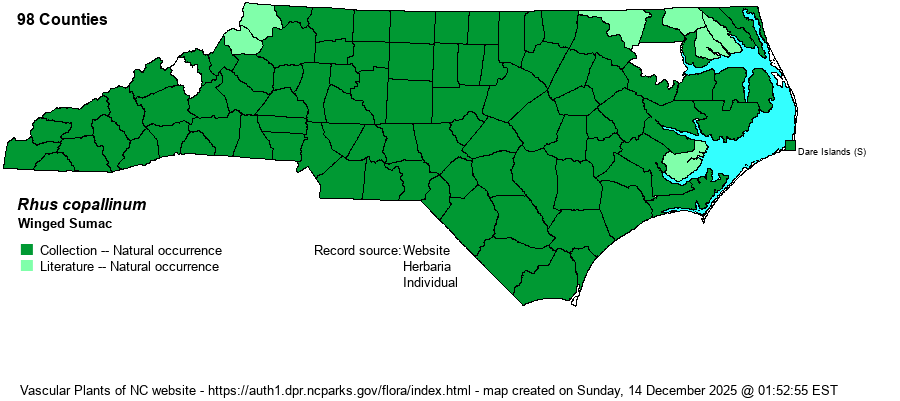| Author | L. | |
| Distribution | Statewide, and likely occurs in all 100 counties.
The species occurs over the entire eastern U.S., except for northern ME and MN. It ranges south to the Gulf Coast and west to southeastern NE and most of TX.
| |
| Abundance | Common across the entire state, if not very common in many areas. By far, the most numerous of the erect species of sumacs in the state. It is often seen daily by the average field biologist. | |
| Habitat | This species has a very wide array of habitats, favoring none. It occurs in old fields, fencerows, thickets, open woods, maritime forests, sandhills, and many other forested types, though not usually found in wet or overly dry sites nor in deep shade. |
| Phenology | Flowers from July to September; fruits from August to October. | |
| Identification | This is normally a medium-sized to rather tall deciduous shrub, growing to 8-10 feet tall, but it may be considered at times a small tree, rarely reaching 12 feet tall. It has alternate, pinnate leaves (usually 9-11 leaflets) that are quite shiny above. The leaf stem has characteristic “wings” on each side, making it very easy to separate from other pinnate-leaved woody plants. Each leaflet is entire, lanceolate to elliptic, and reaches about 2-3 inches long. As with several other shrub sumacs, the inflorescence is a large terminal panicle of hundreds of small green-yellow flowers. A month or two later, hundreds of small dark drupes (berries) appear. You should have little trouble identifying this species; however, it does hybridize with a few other species, including the very rare Rhus michauxii. So, if the sumac looks a bit odd, it might be a hybrid. | |
| Taxonomic Comments | Recently, the specific epithet has been changed to copallinum, instead of copallina. Two varieties occur in the state, with the nominate form – R. copallinum var. copallinum – occurring statewide and R. copallinum var. latifolia being found only in the Mountains and Piedmont. A modern revision of this highly diverse and widespread species is needed.
| |
| Other Common Name(s) | Shining Sumac is another widely used name. Lesser names in use include Dwarf Sumac and Flameleaf Sumac. | |
| State Rank | S5 | |
| Global Rank | G5 | |
| State Status | | |
| US Status | | |
| USACE-agcp | UPL link |
| USACE-emp | FACU link |

